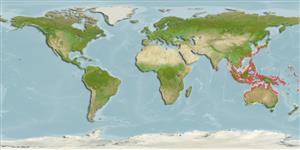Common names from other countries
>
Gobiiformes (Gobies) >
Gobiidae (Gobies) > Gobiinae
Etymology: Gobiopsis: Latin, gobius = gudgeon + Greek, opsis = appearance (Ref. 45335).
More on author: Snyder.
Environment: milieu / climate zone / depth range / distribution range
Ecologia
marinhas demersal; intervalo de profundidade 5 - 15 m (Ref. 90102). Tropical
Indo-West Pacific: Japan south to Australia.
Tamanho / Peso / Idade
Maturity: Lm ? range ? - ? cm
Max length : 1.6 cm SL macho/indeterminado; (Ref. 38029)
Descrição suscinta
Chaves de identificação | Morfologia | Morfometria
Espinhos dorsais (total) : 6 - 7; Raios dorsais (total) : 9 - 11; Espinhos anais: 1; Raios anais : 9. Characterized by pale grey overall body color; mottled brown head, broad saddle over nape region; presence of three brown saddles along base of dorsal fins, joined at midbody to form continuous midlateral stripe; 5-6 narrow brown bars on lower side; fully united pelvic fins, frenum present; relatively short pelvic fins, about 54%distance from origin of pelvic fin to origin of anal fin; rounded caudal fin; longitudinal scale series 33-36; presence of barbels on snout, tip of chin, and ventrally below lower jaw; cycloid scales; cheek and opercle without scales; deeply embedded nape scales; presence of sensory pores on head, no preopercular pores; depth of body 5.7 in SL (Ref. 90102).
Cryptic inhabitant of sand-rubble bottom next to reefs in 5-15 (Ref. 90102).
Ciclo de vida ou comportamento de acasalamento
Maturities | Reprodução | Spawnings | Egg(s) | Fecundities | Larvas
Masuda, H., K. Amaoka, C. Araga, T. Uyeno and T. Yoshino, 1984. The fishes of the Japanese Archipelago. Vol. 1. Tokai University Press, Tokyo, Japan. 437 p. (text). (Ref. 559)
Status na Lista Vermelha da UICN (Ref. 130435)
CITES (Ref. 128078)
Not Evaluated
Ameaça para os humanos
Harmless
Uso pelos humanos
Pescarias: sem interesse
Ferramentas
Relatórios especiais
Baixar XML
Fontes da internet
Estimates based on models
Preferred temperature (Ref.
115969): 25.2 - 29.3, mean 28.6 (based on 1983 cells).
Índice de diversidade filogenética (Ref.
82804): PD
50 = 0.5001 [Uniqueness, from 0.5 = low to 2.0 = high].
Bayesian length-weight: a=0.00708 (0.00333 - 0.01504), b=3.09 (2.92 - 3.26), in cm Total Length, based on LWR estimates for this (Sub)family-body shape (Ref.
93245).
Nível Trófico (Ref.
69278): 3.0 ±0.3 se; based on size and trophs of closest relatives
Resiliência (Ref.
120179): Elevada, tempo mínimo de duplicação da população menor que 15 meses (Preliminary K or Fecundity.).
Fishing Vulnerability (Ref.
59153): Low vulnerability (10 of 100).
